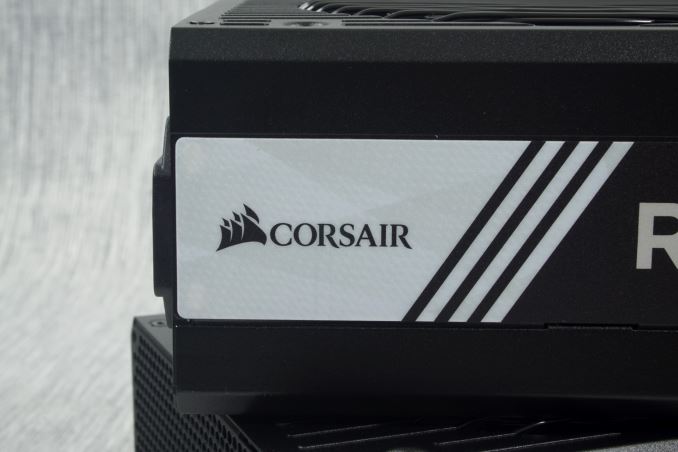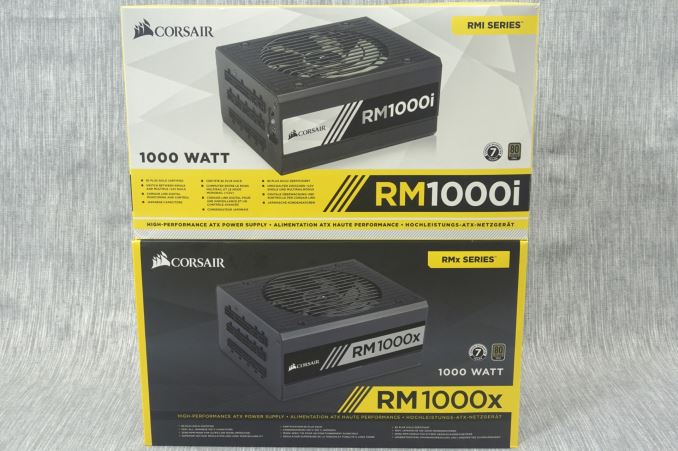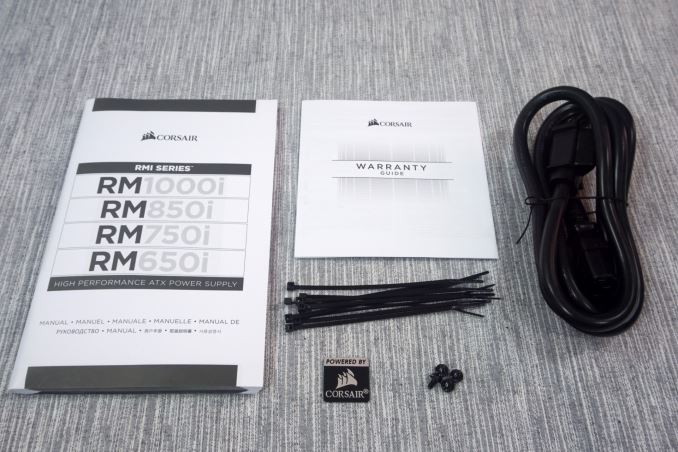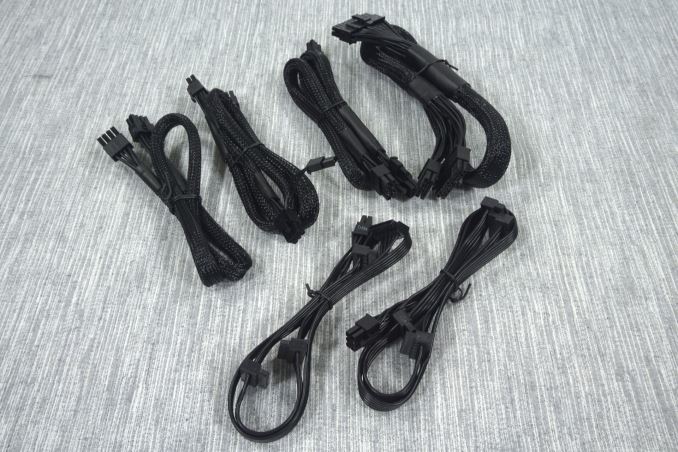The Corsair RM1000x and RM1000i 1000W Power Supply Review
by E. Fylladitakis on September 30, 2015 8:00 AM EST- Posted in
- Cases/Cooling/PSUs
- Corsair
- RM Series
- Corsair Link

Corsair might have started off as a computer memory manufacturer, but today they sell a number of components for PCs. One of their most active product lineups is their computer power supply units (PSUs) business, with the company offering dozens of products through six different series. Each of their PSU series has been designed with a specific target group in mind, ranging from the low-cost VS series to the top-performance AX series. Amongst them, the RM series consists of units with modular cables that have been designed with low noise operation in mind.
We had our first take on the RM series one and a half year ago with the review of the RM1000, which was the pinnacle of the RM series at the time. A few months ago, Corsair upgraded the RM series, presenting the RM-i series that also featured Corsair's Link interface. This week, the company is further releasing the RM-x series, which are an upgrade of the original RM series, receiving essentially the same upgrade as the RM-i units but leaving out the Corsair Link support. Corsair has provided us with an RM1000i and an RM1000x for evaluation, both of which we will have a look at in this review.
| Power specifications ( Rated @ 50 °C ) | |||||
| AC INPUT | 100 - 240 VAC, 50 - 60 Hz | ||||
| RAIL | +3.3V | +5V | +12V | +5Vsb | -12V |
| MAX OUTPUT | 25A | 25A | 83.3A | 3A | 0.8A |
| 150W | 1000W | 15W | 9.6W | ||
| TOTAL | 1000W | ||||
Packaging and Bundle
Corsair supplies the RM1000i and the RM1000x into large, tough cardboard boxes. The packaging is virtually identical, with the only major difference being the main color, which is white for the former and black for the latter. A lot of information regarding the PSU has been printed on all sides of the box, in multiple languages.
The company kept the bundle simple, supplying only the standard AC power cable, a manual and four black mounting screws, as well as a case badge and a few cable ties.
Both of the new RM units comes with the same number of cables and connectors, with the exception of the extra internal USB cable that the -i variation has for the Corsair Link interface. The SATA/Molex cables are flat, ribbon-like cables, while the thicker ATX/EPS/PCI-E cables are sleeved. All of the wires are black.
The following table lists the number of connectors.
| Corsair RM1000x/RM1000i | ||
| Connector type | Hardwired | Modular |
| ATX 24 Pin | - | 1 |
| EPS 4+4 Pin | - | 2 |
| EPS 8 Pin | - | - |
| PCI-E 6+2 Pin | - | 8 |
| PCI-E 8 Pin | - | - |
| SATA | - | 12 |
| Molex | - | 11 |
| Floppy | - | 2 |













47 Comments
View All Comments
elforeign - Wednesday, September 30, 2015 - link
I do remember seeing that this was accounted for in the Cablemod custom cables and they do indeed have the proper cabling design to uphold the ripple suppression seen in the stock cables.FriendlyUser - Wednesday, September 30, 2015 - link
Great review as usual. I was wondering why nobody makes PSUs with EPS 8pin outputs... Such high-wattage units would be perfect for a dual-CPU WS.jonnyGURU - Wednesday, September 30, 2015 - link
What do you mean? MOST PSUs have EPS 8-pin connectors. Typically two for dual CPU WS's.FriendlyUser - Thursday, October 1, 2015 - link
I am sorry, I read the table quickly and just saw the line EPS-8pin empty. However, I still don't get what sort of PSU I need to power, for example, an ASUS X99-E WS, which needs (I quote from the ASUS website):2 x 8-pin EATX 12 V Power connector
1 x 6-pin EATX 12 V_1 Power connector(s)
1 x 24-pin EATX Power connector(s)
1 x 8-pin ATX 12V Power connector(s)
DanNeely - Thursday, October 1, 2015 - link
Looking at the manual (as opposed to the speclist) or pictures of the board it only has 1x24, 2x8, and 1x6 pin power connectors. The two 8 pin ones are at the top of the board and presumably are 8 pin EPS connectors. The 6pin is between the CPU and 1st PCIe slot, I assume it's a PCIe power connector. The two 8 pin and 1 6 pin connectors have opposite polarities (the 8pins have the 12V on the side with the clip, the 6pin has the ground on the clip side); which fits my recollection of differences between the two types of 12V connectors but I don't recall which is which. No clue where the supposed 3rd 8pin connector came from...DanNeely - Wednesday, September 30, 2015 - link
They do, generally in 4+4 type (eg the two EPS 4+4 Pin from the feature table here). If you have both halves of the 4+4 together it's an 8pin EPS connector. If you pop the plug apart you get a 4 pin "P4" connector suitable for use with older/low power systems or as supplemental power on some enthusiast boards. (My LGA 1151 board has both an 8 pin EPS and 4 pin P4 power connector, with the latter to provide more power for overclocking - not sure why they didn't just do 2x 8pin connectors honestly, even if they didn't need it for the CPU might be enough to remove the need for an optional PCIe6 connector around the expansion card area to power 3 way GPU setups.)extide - Wednesday, September 30, 2015 - link
Probably because they couldn't ship that much current from above the cpu socket where that connector most likely was down to the pcie slots without significant voltage drop, making it ~pointless. With really high current on a PCB you want that connector as close to the point of load as possible. I mean even with 2 oz copper you are looking at a pretty fat trace, and boards these days are pretty packed ... So you are talking about possibly adding in 2 entire extra layers...FriendlyUser - Thursday, October 1, 2015 - link
You're right, I misread the EPS-8 line which was empty and did not notice the 4+4 part. Thanks for your comment.lozikosaz - Wednesday, September 30, 2015 - link
I wish that Anandtech made more reviews for PSU in the range of 500/750W.Even entusiast PCs are maxed at that power. Even with multiple GPU.
It does not make sense to use more PSUs of higher wattage than needed, because efficiency drops, and efficiency on idle or light use (like browsing Internet or using office tools), is much worse with a high wattage PSU.
Arbie - Wednesday, September 30, 2015 - link
@lozikosaz - What do you mean? By my count, at least six people are interested in this, though of course not all will buy it.